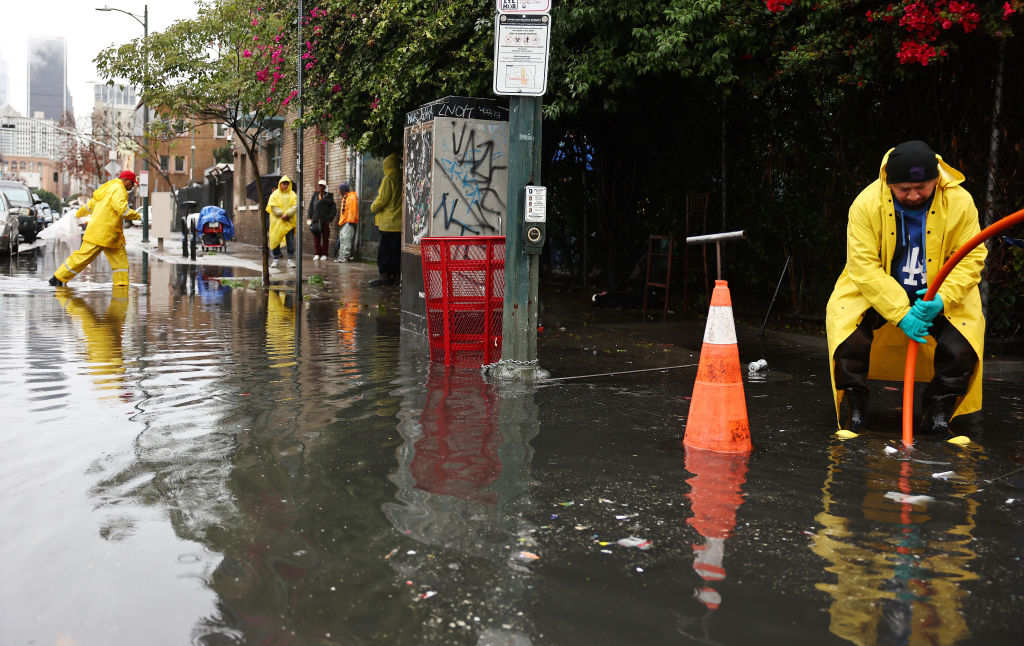Though it is internationally known for its catastrophic wildfires and earthquakes, California is no stranger to floods — particularly during the heavy rains that accompany its winters. In fact, 7 million Californians live in flood-prone areas. Despite this, just one in four Golden State homes sitting in what the federal government considers a flood hazard zone are covered by flood insurance. That gap spells trouble for thousands of homeowners in Southern California, which has been battered by a series of storms over the last week.
The torrential rain and wind are the result of what’s called an atmospheric river, a channel of moisture that can be up to 375 miles wide and carry the equivalent of two Amazon Rivers’ worth of water. Downed trees and mudslides that resulted from the downpour killed nine people, and half a million homes and businesses went without power across the state in recent weeks.
San Diego and Los Angeles, where the river stalled out and dumped more than 10 inches of rain, were hit the hardest. Thousands of homeowners trying to repair the water damage are now in for a rude surprise when they discover that their standard-issue home insurance doesn’t cover floods. The lack of protection stems not only from misperceptions about the likelihood of flooding in sunny California and common misunderstandings of what basic home insurance covers, but also regulatory shortcomings by the federal government, which is supposed to ensure that all the country’s high-risk homes are insured in the event of floods. As climate change intensifies the state’s atmospheric river storms, the problem is only poised to grow.
“[Flood insurance] uptake in California is half the national average,” said Jeffrey Mount, a geomorphologist and a senior fellow at the nonprofit Public Policy Institute of California. “We’re really bad when it comes to that.”
In the eight Southern California counties where the governor has declared an emergency, roughly 52,000 homes and businesses are covered by flood insurance. That’s less than 1 percent of the total number of homes in the region. One reason is cost: A yearly flood policy can cost between $500 and $1,000. In a state with a housing crunch and high cost of living, purchasing flood insurance may be out of reach for many residents who already struggle with the required cost of homeownership, including standard home insurance. Mount added that severe flooding events are quickly forgotten even by those who have lived through them, especially in a state where so many other ecological crises are constantly in the headlines.
“Disaster fatigue is a real thing,” said Mount. “People wear out hearing they’re going to die from earthquakes, fires, and floods, and they get numb, and they don’t take actions to protect themselves.”
Such concerns are only likely to increase in a warming world. A warmer atmosphere and ocean mean an atmospheric river can pick up more water as it crosses the ocean before dumping water on land. The presence of a strong El Niño, a weather pattern that is characterized by warmer Pacific Ocean temperatures, also supercharged the atmospheric river that hit California this month.
“The combination of a warming atmosphere and co-occurrence of the El Niño event both conspired to generate the conditions we’ve seen now along with a healthy dose of random luck,” said Daniel Swain, a climate scientist at the University of California, Los Angeles. Although attribution studies have not yet been conducted on the atmospheric river that has doused California in the last week, Swain estimated that absent climate change, precipitation levels would have been 5 to 15 percent lower.
“That’s not a small number,” said Swain. “We’re talking about a couple extra inches of rain, and two inches of rain in Los Angeles would be a pretty big storm in its own right in a typical year.”
Flood coverage is mandatory for those obtaining a federally-backed mortgage in a part of the state that the Federal Emergency Management Agency, or FEMA, has deemed a “special hazard flood area.” The policy is supposed to protect both homeowners taking on hundreds of thousands of dollars in debt and the federal government, which ultimately bears the risk when a borrower defaults. However, FEMA, which runs the national flood insurance program, does not keep track of compliance with the rule. Neither do lenders. As a result, a homeowner may purchase a flood policy when they secure a mortgage but fail to renew it in subsequent years. A 2006 FEMA study found that compliance with the requirement ranged between 43 percent in the midwest and 88 percent in western states.
California, however, may be the exception in this latter region. Mount, the water policy expert, found that just a quarter of homes in parts of the state with high flood risk comply with the federal rule.
“Nobody’s policing it,” said Mount. “There’s no mechanism to go in and threaten people and say, ‘If you don’t get flood insurance, we’re going to take your mortgage away from you.’”
Mount added that the floods California has seen in the past month are “not floods of the affluent.” People with low economic resilience are often hit hardest by flooding because they tend not to be able to afford insurance and have limited resources to get back on their feet. For instance, in San Diego, which experienced its rainiest day since 1850 last month, low-income communities and communities of color were among the worst affected by flooding.
“This is a social justice issue,” said Mount. “The people who can least afford it are the ones that usually get whacked, and those same communities can’t come up with the money to try and fix their infrastructure.”




